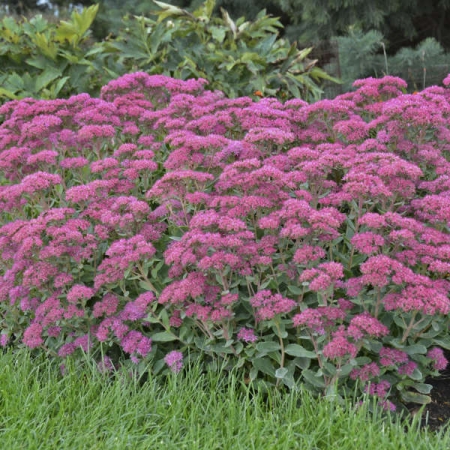Sedum (Stonecrop)
×
Color Name: Carl
Extremely bright and vibrant pink flowers on large heads above fleshy stems to 18" in late summer, for full-sun sites and any soil. Carl display a compact habit and large clusters of brilliant magenta pink flowers held on reddish stems from late summer into fall. Rounded, slightly serrated, grey green leaves form a densely mounded, upright clump. This sedum really packs a punch when it's in bloom.
Tall, upright sedums form substantial clumps of foliage which can be substituted for shrubs in the landscape. Their stout, sturdy stems support the massive flower heads which develop in summer and burst into bloom in fall. If left standing, they provide winter interest and food for birds.
Growing Tips: Sedum is one of the most popular perennials grown in American gardens because it is very easy to grow and hardy in most areas of the country. Because of its thick, succulent leaves which can store water, sedum is drought tolerant. It should be sited in average to poor soil that is well-drained. Plants grown in rich soil tend to be lanky and open. Most varieties should be grown in full sun to light shade. The lower growing types, however, will survive in partial shade.
Divide sedum every 3-4 years to maintain its compact growth habit. Older plants tend to split in the center if they have not been divided. Pinching the taller varieties back by half in early summer will also help prevent them from splitting. This plant is not usually bothered by pests or diseases. The seed heads of the taller varieties provide excellent winter interest and food for birds. Remove them in spring when the new growth begins to show.
Photo courtesy of Walters Garden, Inc.
Extremely bright and vibrant pink flowers on large heads above fleshy stems to 18" in late summer, for full-sun sites and any soil. Carl display a compact habit and large clusters of brilliant magenta pink flowers held on reddish stems from late summer into fall. Rounded, slightly serrated, grey green leaves form a densely mounded, upright clump. This sedum really packs a punch when it's in bloom.
Tall, upright sedums form substantial clumps of foliage which can be substituted for shrubs in the landscape. Their stout, sturdy stems support the massive flower heads which develop in summer and burst into bloom in fall. If left standing, they provide winter interest and food for birds.
Growing Tips: Sedum is one of the most popular perennials grown in American gardens because it is very easy to grow and hardy in most areas of the country. Because of its thick, succulent leaves which can store water, sedum is drought tolerant. It should be sited in average to poor soil that is well-drained. Plants grown in rich soil tend to be lanky and open. Most varieties should be grown in full sun to light shade. The lower growing types, however, will survive in partial shade.
Divide sedum every 3-4 years to maintain its compact growth habit. Older plants tend to split in the center if they have not been divided. Pinching the taller varieties back by half in early summer will also help prevent them from splitting. This plant is not usually bothered by pests or diseases. The seed heads of the taller varieties provide excellent winter interest and food for birds. Remove them in spring when the new growth begins to show.
Photo courtesy of Walters Garden, Inc.
|
Flower Color: Pink shades Foliage Color: Green shades
Height: 18 Inches Spread: 18 to 24 Inches Hardy in Zone: 4, 5, 6, 7 |
Blooms: Late Summer
Foliage Season: All Season |
Growth Rate |
Medium
|
Attributes |
Ground Cover Dried Flower Container Specimen Plant Salt Tolerant Mass Planting Landscapes Evergreen Drought Tolerant Border
|








